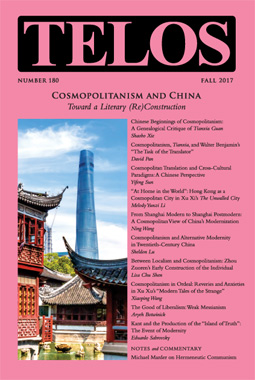Ning Wang’s “From Shanghai Modern to Shanghai Postmodern: A Cosmopolitan View of China’s Modernization” appears in Telos 180 (Fall 2017), a special issue on Cosmopolitanism and China. Read the full article at the Telos Online website, or purchase a print copy of the issue in our online store. Individual subscriptions to Telos are now available in both print and online formats.
 To discuss the issue of cosmopolitanism in the Chinese context is, as in the Western context, no longer new to China’s humanities intellectuals, for this issue once did attract Chinese intellectuals in the 1920s when nationalism dominated Chinese academia and intellectual circles. Furthermore, it indeed had some parallel elements in ancient Chinese philosophy. It is therefore quite natural that cosmopolitanism was not so attractive when China, according to Dr. Sun Yat-sen, was not qualified enough to talk about cosmopolitanism as it was still poor and backward at the time. In the current era of globalization, along with the increasingly important role played by China and its leaders, more and more scholars have been paying considerable attention to this issue with regard to global culture and world literature. But unfortunately, in this field, Chinese scholars have published very little internationally, let alone influencing international scholarship. Thus to discuss cosmopolitanism should also be associated with the issue of modernity in the Chinese context. In my view, we should focus on a specific case study, in the process of which we may well reach a reconstruction of an alternative modernity of oriental or Chinese characteristics. As Shanghai has been a cosmopolitan metropolis since the beginning of the twentieth century, and in recent years playing an increasingly vital role in China’s process of modernization as well as the broader context of the global economy and culture, the present essay will therefore focus on the modernity and cosmopolitanity of Shanghai in an attempt to reach both a deconstruction and reconstruction of global modernity with concrete Chinese practice.
To discuss the issue of cosmopolitanism in the Chinese context is, as in the Western context, no longer new to China’s humanities intellectuals, for this issue once did attract Chinese intellectuals in the 1920s when nationalism dominated Chinese academia and intellectual circles. Furthermore, it indeed had some parallel elements in ancient Chinese philosophy. It is therefore quite natural that cosmopolitanism was not so attractive when China, according to Dr. Sun Yat-sen, was not qualified enough to talk about cosmopolitanism as it was still poor and backward at the time. In the current era of globalization, along with the increasingly important role played by China and its leaders, more and more scholars have been paying considerable attention to this issue with regard to global culture and world literature. But unfortunately, in this field, Chinese scholars have published very little internationally, let alone influencing international scholarship. Thus to discuss cosmopolitanism should also be associated with the issue of modernity in the Chinese context. In my view, we should focus on a specific case study, in the process of which we may well reach a reconstruction of an alternative modernity of oriental or Chinese characteristics. As Shanghai has been a cosmopolitan metropolis since the beginning of the twentieth century, and in recent years playing an increasingly vital role in China’s process of modernization as well as the broader context of the global economy and culture, the present essay will therefore focus on the modernity and cosmopolitanity of Shanghai in an attempt to reach both a deconstruction and reconstruction of global modernity with concrete Chinese practice.



